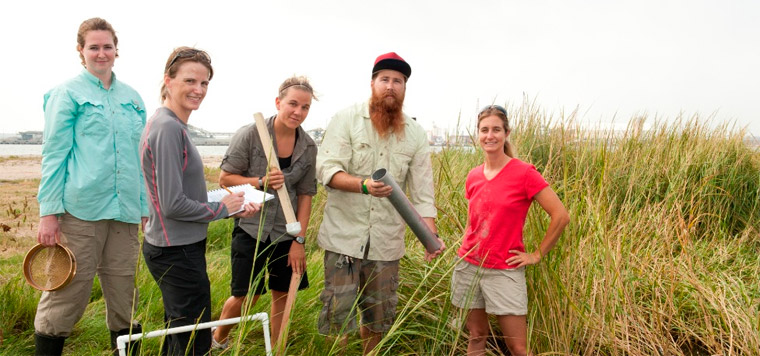About Us

Our Mission
In the Coastal and Wetlands Ecology Laboratory, we examine the community-level interactions and processes that structure coastal ecosystems. Our work spans many coastal habitats, including salt marshes, mangroves, tidal mudflats, seagrass beds, and tidal freshwater wetlands. We are particularly interested in changes in trophic interactions following habitat restoration, nutrient enrichment, or other anthropogenic alterations. In addition, we investigate how plant and animal diversity influence ecosystem functions such as nutrient cycling, nursery habitat, and water quality. We utilize field experiments and a wide array of analytical procedures (stable isotopes, HPLC, stoichiometry) to investigate community dynamics in tropical, subtropical, and temperate environments.
Our ultimate goal is to incorporate our understanding of coastal ecosystem dynamics and processes into the management of restored and anthropogenically impacted habitats. We seek to apply our findings to the design and management of restored coastal wetlands, maintenance of water quality standards in local watersheds, and coastal habitat management in the face of near-term climate change and sea level rise.

Research Projects
Our current research evaluates the influence of habitat restoration, nutrient enrichment, climate change, and other anthropogenic disturbances on coastal wetlands, mangroves, and subtidal seagrass beds. Current projects include:
How effective is dredge material at restoring foraging habitats for coastal birds?
Coastal wetland restoration projects often employ beneficial uses of dredge material techniques to elevate degraded areas so they can support marsh vegetation. One intended outcome is that these new marshes will, in turn, support coastal birds foraging in these habitats. Read more about dredge material at restoring foraging habitats for coastal birds
Restoring coastal wetlands for shorebirds: leveraging lessons learned to identify research priorities and strategies to maximize future success
Shorebird use of restored wetland habitat for foraging or roosting is closely linked to fine-scale elevation features, such as the inclusion of shallow pools for foraging in site design. Integrating small-scale elevation heterogeneity into restoration site design may enhance shorebird use, without diminishing broader success criteria for vegetation cover. Read more about leveraging lessons learned to identify research priorities and strategies
Understanding ecosystem responses to the closure of Rollover Pass on Bolivar Peninsula
The Rollover Pass channel is a man-made strait through the Bolivar Peninsula and links the Gulf of Mexico with Rollover Bay and East Bay in eastern Galveston County. Rollover Pass was originally opened by the Texas Game and Fish Commission in 1954 to increase bay water salinity, promote growth of submerged vegetation, and provide access for marine fish to and from spawning and feeding areas in East Bay. Read more about ecosystem responses to the closure of Rollover Pass
Do mangroves provide better coastal protection than salt marshes? A Hurricane Harvey case study
On the Texas coast, black mangroves are becoming more common, often displacing salt marshes. Dr. Anna Armitage (Professor, Marine Biology, TAMUG) and her colleagues, Dr. Steve Pennings (University of Houston) and Dr. John Kominoski (Florida International University) have been studying the ecological consequences of this mangrove expansion in our region. Hurricane Harvey provided a unique opportunity to answer a critical question: do mangroves provide fundamentally different – or better – shoreline protection than the grasses and shrubs that they replace? Read more about the Hurricane Harvey case study
Mangrove Restoration in Galveston Bay: Ecological Benefits and Effective Restoration Techniques
The objective of this project is to determine if, where, and how mangrove restoration should be implemented in Galveston Bay. In order to yield successful results, coastal wetland restoration strategies need to be adapted to the rapidly-changing coastal landscape. Our goal was to inform best-practices for mangrove (Avicennia germinans) restoration, and to provide recommendations as to if and when coastal wetland restoration efforts should include mangrove plantings. Read more about Mangrove Restoration in Galveston Bay
Ecosystem restoration: ecological restoration of emergent coastal marshes and aquatic habitats
As our understanding of complex biotic and abiotic links between emergent marshes and adjacent aquatic habitats increases, restoration approaches must also increase in complexity. The development of plant canopy features is often considered to be a sign of successful coastal marsh restoration, but a robust plant canopy may not correspond with the recovery of other ecosystem attributes such as nutrient retention or energy flow through food webs... Read more about Ecosystem restoration
Changing coastal ecosystems: causes and consequences of mangrove expansion into northern Gulf of Mexico salt marshes
On the Texas coast, black mangroves (Avicennia germinans) regularly expand from persistent populations into salt marshes during periods with warm winters, and occasionally contract in distribution during periods with severe freezes. Over the coming decades, mangrove distributions are expected to continue expanding due to rising global temperatures and milder winters. As a result, large areas of the Texas coast that historically have been dominated by salt marshes will become dominated by mangroves. ... Read more about Changing coastal ecosystems
Blue carbon in coastal wetlands: the effects of restoration and woody encroachment
Carbon can be absorbed from the atmosphere and stored by microbial and plant communities in a process called sequestration. A portion of this carbon is respired by the plants and released back into the atmosphere, but the remainder is converted into biomass that may become sequestered in the soil for decades. Carbon that is sequestered in marine habitats such as marshes, mangroves, and seagrasses, is known as “blue carbon.” Read more about Blue carbon in coastal wetlands
